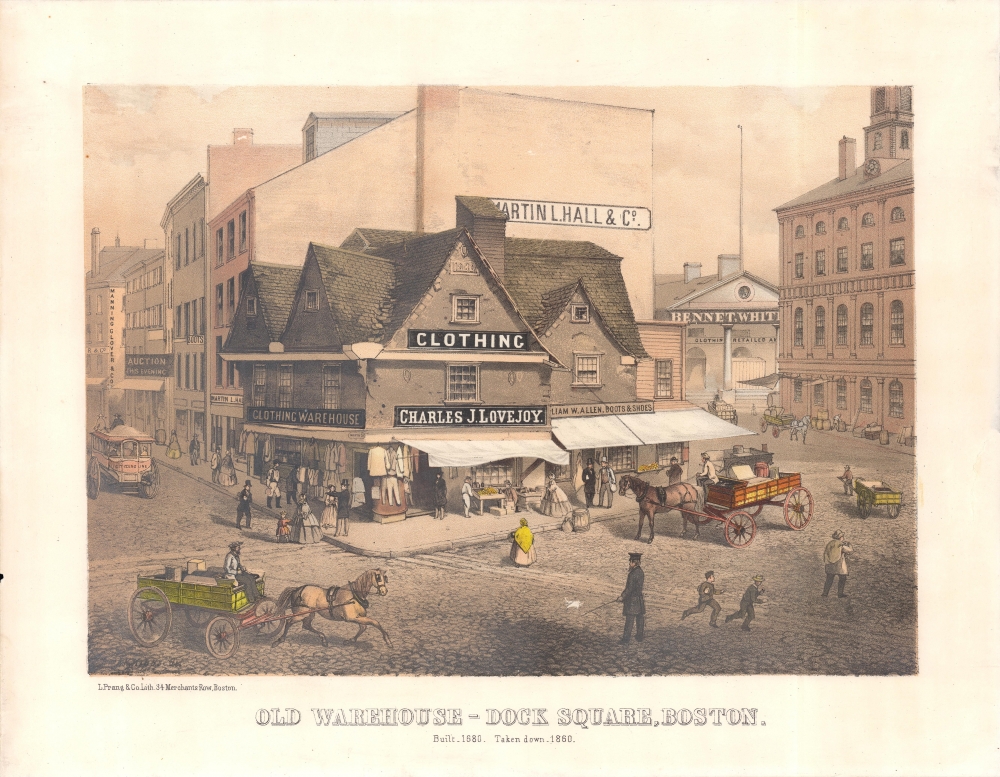1861 Prang View of Old Feather Store, Dock Square and Faneuil Hall, Boston
DockSqBoston-prang-1861
Title
1861 (undated) 12 x 15 in (30.48 x 38.1 cm)
Description
A Closer Look
Oriented roughly towards the southeast, this view focuses on the Old Feather Store, a building constructed in 1680 in Boston's Dock Square, located near what is today 1 Union St. One side of Faneuil Hall appears at right, while Quincy Market sits behind it in the background. Other nearby clothiers are depicted, along with shoppers, traders, and playing children. At left is a horse-drawn omnibus of the Citizen's Line, an early form of public transportation.The Old Feather Store
The Old Feather Store, so named because the shop on its first floor specialized in selling feathers in the early 19th century, was constructed in 1680. It was notable for its size, gables, overhangs, and distinctive exterior cement composed of gravel and shards of colored broken glass. Though its first-floor commercial space was put to various uses in the nearly two century history of the building, it generally housed some sort of clothing store. Had the building survived instead of being taken down in 1860, it would be among the oldest in Boston today (the famous 'Paul Revere House' was built the same year).Publication History and Census
This view was drawn by Alfred Kemble Kipps (his name is barely legible at bottom-left) and was lithographed by Louis Prang in Boston. It is undated but was likely issued soon after the building's demolition in 1860. It is listed among the institutional holdings of the Boston Athenaeum, the American Antiquarian Society, the Museum of Fine Arts, Boston, the Huntington Library, and the Smithsonian Institution.CartographerS
Louis Prang (March 12, 1824 - September 14, 1909) was a Boston based publisher of lithographs and chromolithographs active in the latter half of the 19th century. Prang was born in Breslau Germany where he studied printmaking and engraving from his father, a noted master of the calico process. Around 1850, Prang immigrated to the United States fearing political persecution in Germany after the failed Springtime of the Peoples Revolution, making him a 48er. In the United States, Prang partnered with another German Printmaker, Julius Mayer, establishing the short-lived Prang & Mayer firm. Ten years later, in 1860, Prang started his own chromolithography firm, L. Prang & Co. Prang quickly established himself as a publisher of post cards and other small prints, which were popular as gifts and collectibles. He was especially successful with mass-produced overviews of major battles in the U.S. Civil War, and his 'War Telegram Marking Map' was memorable for being sold with colored pencils, allowing buyers to track the movement of armies over time. Many consider him to be the "Father of the American Christmas Card". Prang also issued larger format chromolithographs of popular art and even printed his own magazine to the effect Prang's Chromo: A Journal of Popular Art. Through his magazines and limited edition printings, Prang was influential in establishing the popularity of the chromolithographic process in America. More by this mapmaker...
Alfred Kemble Kipps (c. 1833 - 1900), usually signed as 'A.K. Kipps,' was an English-born American photographer, painter, and artist specializing in portraiture and drawings of trees who spent his career in Northern California. Settling first in San Francisco around 1863, he moved to Oakland in 1869 before returning to San Francisco in 1880 to pursue business ventures related to photography, copying, and artistic prints with various partners. Learn More...

